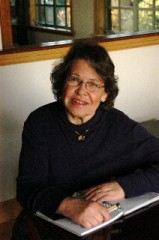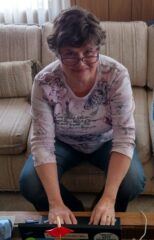 Friday, March 12, 2021
Friday, March 12, 2021
12pm
What sparks a captivating story? Do writing ideas just appear out of nowhere? Do authors sit around waiting for great ideas to emerge, or do they systematically go out and find them?
Join five published authors as they demystify what often appears as an inexplicable black box. They will share how and where they find the inspiration for their writing, ranging from lucid dreams, people watching, historical events, and more. Bring your questions about writers’ sources of inspiration for them to answer at the end of the session.
Moderator:
 Nita Sweeney is the award-winning wellness author of the running and mental health memoir, Depression Hates a Moving Target: How Running with My Dog Brought Me Back from the Brink and co-creator of the writing journal, You Should Be Writing: A Journal of Inspiration & Instruction to Keep Your Pen Moving. A long-time meditator, three-time marathoner, and former assistant to writing practice originator Natalie Goldberg, Nita founded the Facebook group Mind, Mood, and Movement to support mental well-being through meditation, exercise, and writing practice. Nita’s eBook Three Ways to Heal Your Mind is available for download.
Nita Sweeney is the award-winning wellness author of the running and mental health memoir, Depression Hates a Moving Target: How Running with My Dog Brought Me Back from the Brink and co-creator of the writing journal, You Should Be Writing: A Journal of Inspiration & Instruction to Keep Your Pen Moving. A long-time meditator, three-time marathoner, and former assistant to writing practice originator Natalie Goldberg, Nita founded the Facebook group Mind, Mood, and Movement to support mental well-being through meditation, exercise, and writing practice. Nita’s eBook Three Ways to Heal Your Mind is available for download.
Panelists:
 Goal-setting expert Debra Eckerling is the author of Your Goal Guide: A Roadmap for Setting, Planning & Achieving Your Goals and founder of the D*E*B METHOD. Debra helps individuals and businesses figure out what they want and how to get it through one-on-one coaching, workshops, and online support. She is the founder of Write On Online, a website and community for writers, creatives, and entrepreneurs, as well as host of the #GoalChat Twitter chat and #GoalChatLive on Facebook.
Goal-setting expert Debra Eckerling is the author of Your Goal Guide: A Roadmap for Setting, Planning & Achieving Your Goals and founder of the D*E*B METHOD. Debra helps individuals and businesses figure out what they want and how to get it through one-on-one coaching, workshops, and online support. She is the founder of Write On Online, a website and community for writers, creatives, and entrepreneurs, as well as host of the #GoalChat Twitter chat and #GoalChatLive on Facebook.
 Storyteller, author, librarian Kate Farrell is the author of Story Power: Secrets to Creating, Crafting, and Telling Memorable Stories. Kate founded the Word Weaving Storytelling Project and published numerous educational materials on storytelling. She has contributed to and edited award-winning anthologies of personal narrative, Times They Were A-Changing: Women Remember the 60s & 70s, and Cry of the Nightbird: Writers Against Domestic Violence.
Storyteller, author, librarian Kate Farrell is the author of Story Power: Secrets to Creating, Crafting, and Telling Memorable Stories. Kate founded the Word Weaving Storytelling Project and published numerous educational materials on storytelling. She has contributed to and edited award-winning anthologies of personal narrative, Times They Were A-Changing: Women Remember the 60s & 70s, and Cry of the Nightbird: Writers Against Domestic Violence.
 Marlena Fiol, PhD is a world-renowned expert on why and how people change their understanding of who they are. Her significant body of published material on the topic, coupled with her own raw identity-changing experiences, makes her uniquely qualified to speak and write about deep change. Her latest book Nothing Bad Between Us: A Mennonite Missionary’s Daughter Finds Healing in Her Brokenness is a vulnerable and inspirational tale of personal transformation. Marlena lives with her husband Ed in Eugene, Oregon. To learn more, please visit marlenafiol.com.
Marlena Fiol, PhD is a world-renowned expert on why and how people change their understanding of who they are. Her significant body of published material on the topic, coupled with her own raw identity-changing experiences, makes her uniquely qualified to speak and write about deep change. Her latest book Nothing Bad Between Us: A Mennonite Missionary’s Daughter Finds Healing in Her Brokenness is a vulnerable and inspirational tale of personal transformation. Marlena lives with her husband Ed in Eugene, Oregon. To learn more, please visit marlenafiol.com.
 The author of three poetry collections, a chapbook of short fiction and You Can Be a Winning Writer, a book for writers, Joan Gelfand’s work appears in national and international journals including Rattle, PANK! The Los Angeles Review of Books, Prairie Schooner, Kalliope, California Quarterly, the Toronto Review, Marsh Hawk Review and Levure Litteraire. Her chapbook of short fiction won the Cervena Barva Fiction Award. President Emeritus of the Women’s National Book Association, a member of the National Book Critics Circle and California Writers Club, Joan coaches writers. Joan’s novel, Extreme, set in a Silicon Valley startup, was published by Blue Light Press in July, 2020.
The author of three poetry collections, a chapbook of short fiction and You Can Be a Winning Writer, a book for writers, Joan Gelfand’s work appears in national and international journals including Rattle, PANK! The Los Angeles Review of Books, Prairie Schooner, Kalliope, California Quarterly, the Toronto Review, Marsh Hawk Review and Levure Litteraire. Her chapbook of short fiction won the Cervena Barva Fiction Award. President Emeritus of the Women’s National Book Association, a member of the National Book Critics Circle and California Writers Club, Joan coaches writers. Joan’s novel, Extreme, set in a Silicon Valley startup, was published by Blue Light Press in July, 2020.
Title: Panel: Where Do Writers Get Their Ideas?
When: Friday, March 12, 12pm PT
Where: Zoom (Zoom link provided via email when you RSVP)
Unable to attend? No worries. Register anyway and receive the replay!
Click the button below to RSVP for the panel discussion; we are limited to 100 total attendees, so please let us know early!


 As a consultant and professor of strategic management, Marlena Fiol, PhD, guided her students and clients in coming to know themselves deeply, visualizing their dreams and identifying and removing the barriers to achieve them. Over half of her 85 published articles and books relate to identity and identity change. Her work has been cited over 20,000 times.
As a consultant and professor of strategic management, Marlena Fiol, PhD, guided her students and clients in coming to know themselves deeply, visualizing their dreams and identifying and removing the barriers to achieve them. Over half of her 85 published articles and books relate to identity and identity change. Her work has been cited over 20,000 times. 
 You polish your writing, imagining your audience. You read it over. Out loud. Does it say exactly what you want it to say? You have a friend read it to you. Impressed, she says, “You should submit this to contests. Put yourself out there. Get some recognition for your work.”
You polish your writing, imagining your audience. You read it over. Out loud. Does it say exactly what you want it to say? You have a friend read it to you. Impressed, she says, “You should submit this to contests. Put yourself out there. Get some recognition for your work.”
 Wooden spoon puppets can create holiday magic.
Wooden spoon puppets can create holiday magic.  Kate Farrell,
Kate Farrell,  I learned about “To Write” lists from best-selling author Natalie Goldberg, of
I learned about “To Write” lists from best-selling author Natalie Goldberg, of  Nita Sweeney is co-author with Brenda Knight of the writing journal,
Nita Sweeney is co-author with Brenda Knight of the writing journal, 